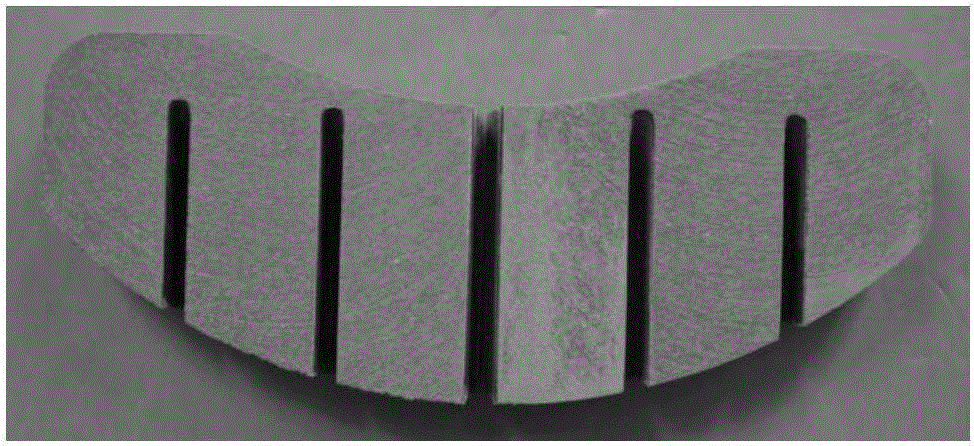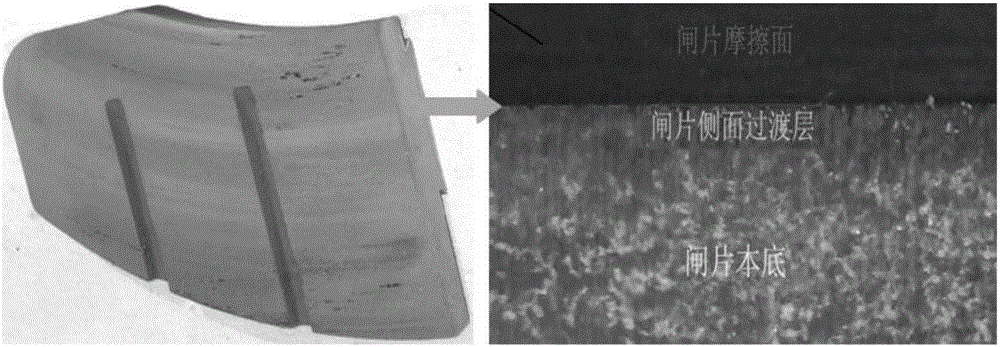Train brake pad/brake shoe with stable braking performance and preparation method thereof
A technology for trains and brake pads, applied in the field of train brake pads/brake shoes and their preparation, can solve problems such as weak "instant" stabilization control, and achieve the effects of reducing elastic modulus, improving adhesion properties, and stabilizing friction work.
- Summary
- Abstract
- Description
- Claims
- Application Information
AI Technical Summary
Problems solved by technology
Method used
Image
Examples
Embodiment 1
[0070] Train brake pads / brake shoes, consisting of the following components by weight: 10 parts of natural cellulose, 3 parts of magnesium naphthenate, 2 parts of phosphate, 5 parts of powdered nitrile rubber, 5 parts of epoxy, modified phenolic 20 parts of resin, 10 parts of steel fiber, 5 parts of pyrite powder, 15 parts of petroleum coke, 10 parts of mica powder, and 15 parts of barium sulfate.
[0071] The preparation method of the train brake pad / brake shoe is as follows:
[0072]After fully mixing 10 parts of natural cellulose with 3 parts of magnesium naphthenate, 2 parts of sodium pyrophosphate, 5 parts of epoxide and 10 parts of ethanol, add it to a screw extruder granulator for granulation, and place it at room temperature for 4 hours. The produced granules are rolled into 1.5mm thin chips, and dried with hot air at 70°C for half an hour to remove ethanol; the above-mentioned flakes are mixed with 5 parts of powdered nitrile rubber, 20 parts of modified phenolic resi...
Embodiment 2
[0079] The train brake pad / brake shoe is composed of the following components by weight: 10 parts of calcium alginate, 2 parts of magnesium naphthenate, 2 parts of sodium hexametaphosphate, 6 parts of SBS rubber, 6 parts of epoxy, modified phenolic 18 parts of resin, 14 parts of steel fiber, 12 parts of zircon powder, 10 parts of pitch coke, 10 parts of organically modified clay, and 10 parts of barium sulfate.
[0080] The preparation method of the train brake pad / brake shoe is as follows:
[0081] 10 parts of calcium alginate, 2 parts of magnesium naphthenate, 2 parts of sodium hexametaphosphate, 6 parts of epoxide and an appropriate amount of ethanol are fully mixed and then extruded into granules. After standing at room temperature for 8 hours, the granules are rolled into into 1mm thin chips, and dried with hot air at 70°C to remove ethanol; the above flakes, 6 parts of SBS rubber, 18 parts of modified phenolic resin, 14 parts of steel fiber, 12 parts of zircon powder, 10...
Embodiment 3
[0087] The train brake pad / brake shoe is composed of the following components by weight: 6 parts of cellulose, 4 parts of chitosan, 5 parts of chitin, 5 parts of magnesium naphthenate, 3 parts of potassium pyrophosphate, carboxylated nitrile rubber powder 12 parts, 9 parts of epoxy, 24 parts of methylol nylon modified phenolic resin, 10 parts of steel fiber, 7 parts of γ-alumina, 5 parts of nano-reinforced carbon black, and 10 parts of palygorskite powder filler.
[0088] The preparation method of the train brake pad / brake shoe is as follows:
[0089] Fully mix 6 parts of cellulose, 4 parts of chitosan, 5 parts of chitin, 5 parts of magnesium naphthenate, 3 parts of potassium pyrophosphate, 9 parts of epoxide and an appropriate amount of ethanol, then extrude and granulate, and place at room temperature for 8 Hours later, the produced granules were rolled into 1mm thin chips, and dried with hot air at 70°C to remove ethanol; the above thin sheets were mixed with 12 parts of ca...
PUM
| Property | Measurement | Unit |
|---|---|---|
| particle size | aaaaa | aaaaa |
| particle diameter | aaaaa | aaaaa |
| thickness | aaaaa | aaaaa |
Abstract
Description
Claims
Application Information
 Login to View More
Login to View More - R&D
- Intellectual Property
- Life Sciences
- Materials
- Tech Scout
- Unparalleled Data Quality
- Higher Quality Content
- 60% Fewer Hallucinations
Browse by: Latest US Patents, China's latest patents, Technical Efficacy Thesaurus, Application Domain, Technology Topic, Popular Technical Reports.
© 2025 PatSnap. All rights reserved.Legal|Privacy policy|Modern Slavery Act Transparency Statement|Sitemap|About US| Contact US: help@patsnap.com



